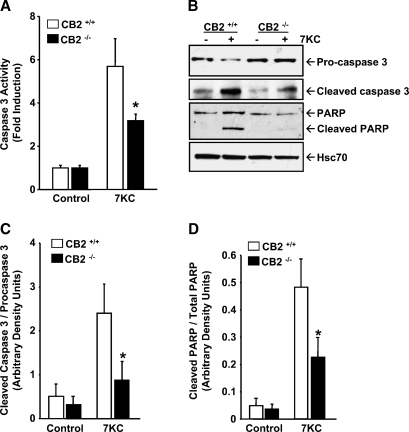Fig. 3.
Activation of caspase-3 by 7-ketocholesterol is reduced in CB2 deficient macrophages. Resident peritoneal macrophages, isolated and pooled from CB2+/+ and CB2−/− mice, were cultured for 16 h in the presence or absence of 10 μg/ml 7KC. A: Caspase-3 activity was determined as described in Materials and Methods, and the results are present as the mean fold induction ± SD for three independent experiments. B: Total cell lysates prepared from CB2+/+ and CB2−/− MPMs treated with and without 7KC for 16 h were subjected to immunoblotting using antibodies specific for procaspase-3, cleaved caspase-3 and poly-ADP ribose polymerase (PARP). The blots were striped and probed with an Hsc70 antibody to control for equal loading of the gels. The blots shown are representative of three independent experiments. C: The relative amounts of procaspase-3, cleaved caspase-3, full length PARP and cleaved PARP detected by the immunoblots from the three replicate experiments were quantified by densitometric analysis, normalized to Hsc70 levels, and expressed as the mean ratio of cleaved caspase-3 / procaspase-3 ± SD (C) and as the mean ratio of cleaved PARP / total PARP ± SD, respectively (D). * P < 0.05 between similarly treated CB2−/− and CB2+/+ macrophages.

